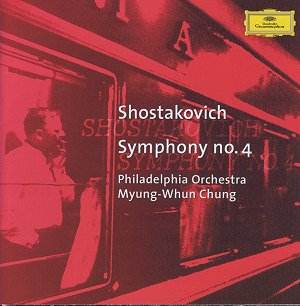 Composer: Dmitri Shostakovich
Composer: Dmitri Shostakovich
Works: Symphony No. 4
Performers: Philadelphia Orchestra, Myung-Whun Chung (conductor)
Recording: November 1994, Memorial Hall, Philadelphia
Label: Deutsche Grammophon (DG 447 759-2)
Dmitri Shostakovich’s Symphony No. 4 is a monumental work that encapsulates the turmoil and complexity of its time. Completed in 1936 but withdrawn before its scheduled premiere due to the political climate under Stalin, the symphony ultimately remained unheard until 1961. Its historical context is crucial; it was composed during a period of intense scrutiny and danger for the artist, reflecting both personal and societal upheaval. The symphony’s three movements span over an hour, showcasing a vast orchestral palette that demands both technical prowess and interpretative depth.
Myung-Whun Chung conducts the Philadelphia Orchestra with commendable precision, yet his interpretation raises questions about the symphonic vision and continuity inherent in Shostakovich’s score. The orchestra performs with remarkable cohesion; each section conveys clarity and power, particularly in the opening movement, where a colossal percussive chord introduces a world of tension and expectation. However, Chung’s pacing often feels rushed, particularly in the outer movements, where the composer’s intricate counterpoint and thematic development require a more deliberate approach. The fast string fugue in the first movement, marked Presto, is executed with virtuosic flair, yet the energetic drive occasionally sacrifices the crucial subtleties of articulation that contribute to the work’s emotional weight.
The central scherzo stands out for its atmospheric qualities, with Chung achieving a delicate balance between the contrasting dynamics. The diminuendo toward the movement’s close is particularly effective, allowing the music’s inherent tension to unfold gracefully. Yet, the climactic moments, especially in the finale, while sonorous and forceful, lack the profound impact achieved by other conductors. Comparisons with renowned interpretations by Simon Rattle and Mstislav Rostropovich highlight a more cohesive understanding of the symphonic arc, where each phrase builds organically toward its resolution.
Engineered by Deutsche Grammophon, the recording captures the expansive soundscape of the symphony with clarity and depth, effectively rendering the rich timbres of the orchestra. The dynamic range is impressive, ensuring that both the powerful climaxes and the more intimate passages resonate fully. Nonetheless, the recording’s excellence does not entirely compensate for the interpretative shortcomings that emerge in Chung’s direction.
Shostakovich’s Fourth Symphony stands as a towering achievement in the symphonic canon, reflecting the complexity of its creator’s artistic struggles. While this recording by Chung and the Philadelphia Orchestra offers moments of brilliance and technical achievement, it ultimately falls short of delivering the profound emotional journey that the score promises. As a listener, one is left yearning for a more integrated and nuanced interpretation that captures the symphony’s full scope and depth.



